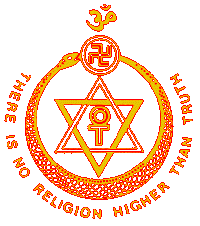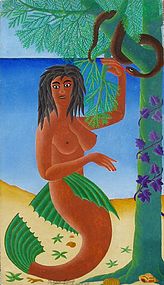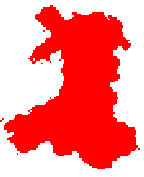Feelgood Theosophy
Welcome to the Feelgood
Lodge

Haitian Voodoo
A positive
religion with
a sinister image

La Sirene
The Haitian Voodoo Goddess of the Sea
and Spirit of the Water
by
Haitian Master Salnave
Philippe-Auguste (1908-1989)
The official
religion of
Misconceptions about Voodoo have given
Adherents of
Voodoo do not perceive themselves as members of a separate religion; they
consider themselves Roman Catholics. In fact, the word for Voodoo does not even
exist in rural
Roman Catholics
who are active Voodooists say that they "serve the spirits," but they
do not consider that practice as something outside of Roman Catholicism.
Haitians also distinguish between the service of family spirits and the
practice of magic and sorcery.
The belief
system of Voodoo revolves around family spirits (often called loua or miste) who are inherited
through maternal and paternal lines.
Loua protect their children from misfortune. In return,
families must feed the loua through periodic rituals
in which food, drink, and other gifts are offered to the spirits.
There are two
kinds of services for the loua. The first is held
once a year; the second is conducted much less frequently, usually only once a
generation. Many poor families, however, wait until they feel a need to restore
their relationship with their spirits before they conduct a service. Services
are usually held at a sanctuary on family land.
In Voodoo, there
are many loua. Although there is considerable
variation among families and regions, there are generally two groups of loua, the rada and the petro. The rada spirits are
mostly seen as "sweet" loua, while the petro are seen as "bitter" because they are more
demanding of their children. Rada spirits appear to
be of African origin while petro spirits appear to be
of Haitian origin
Loua are usually anthropomorphic and have distinct
identities. They can be good, evil, capricious, or demanding. Loua most commonly show their displeasure by making people
sick, and so Voodoo is used to diagnose and treat illnesses. Loua are not nature spirits, and
they do not make crops grow or bring rain. The loua
of one family have no claim over members of other families, and they cannot
protect or harm them. Voodooists are therefore not interested in the loua of other families
Loua appear to family members in dreams and, more
dramatically, through trances.
Many Haitians
believe that loua are capable of temporarily taking
over the bodies of their children. Men and women enter trances during which
they assume the traits of particular loua. People in
a trance feel giddy and usually remember nothing after they return to a normal
state of consciousness. Voodooists say that the spirit temporarily replaces the
human personality. Possession trances occur usually during rituals such as
services for loua or a vodoun
dance in honor of the loua. When loua
appear to entranced people, they may bring warnings or explanations for the
causes of illnesses or misfortune. Loua often engage
the crowd around them through flirtation, jokes, or accusations
Ancestors (le mu) rank with the family loua as
the most important spiritual entities in Voodoo. Elaborate funeral and mourning
rites reflect the important role of the dead. Ornate tombs throughout the
countryside reveal how much attention
Beliefs include
zombies and witchcraft. Zombies are either spirits or people whose souls have
been partially withdrawn from their bodies. Some Haitians resort to boku, who are specialists in sorcery and magic.
Haiti has
several secret societies whose members practice sorcery Voodoo specialists,
male houngan and female manbo,
mediate between humans and spirits through divination
and trance. They diagnose illnesses and reveal the origins of other misfortune.
They can also perform rituals to appease spirits or ancestors or to repel
magic. Many Voodoo specialists are accomplished herbalists who treat a variety
of illnesses Voodoo lacks a fixed theology and an organized hierarchy, unlike
Roman Catholicism and Protestantism. Each specialist develops his or her own
reputation for effectiveness.
President
Francois Duvalier recruited Voodoo specialists to
serve as tonton makouts to
help him control all aspects of Haitian life. Duvalier
indicated that he retained power through sorcery, but because Voodoo is
essentially a family-based cult, Duvalier failed to
politicize the religion to any great extent.
Feelgood Theosophy
Thankyou for visiting the Feelgood Lodge
______________________
An
independent Theosophical Republic
Worldwide
links to FREE online
Courses,
Writings, Commentaries,
Cardiff Lodge’s Instant Guide to Theosophy
The Most Basic Theosophy
Website in the Universe
A quick overview of
Theosophy
and the Theosophical Society
If you run a Theosophy Group
you
can use this as an introductory handout.
Blavatsky Calling and I don’t wanna shout
No
Aardvarks were harmed in the
The Spiritual Home of Urban Theosophy
The Earth Base for Evolutionary Theosophy
Try
these if you are looking for a local group
UK Listing of Theosophical Groups
Worldwide Directory of Theosophical Links
Blog
Links
http://london-underground.blogspot.com
This site is a
directory of weblogs written by
people who live or work in
by the rather iconic London Tube map (and also
the central London suburban rail network,
docklands light railway and Croydon tramlink)
http://londonbloggers.iamcal.com/
British Blog Directory
________________

General pages about
Wales, Welsh History
and The History of Theosophy
in Wales
Wales
is a Principality within the
and
has an eastern border with
area
is just over 8,000 square miles.
The
coastline is almost 750 miles long. The population
of